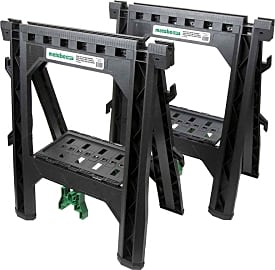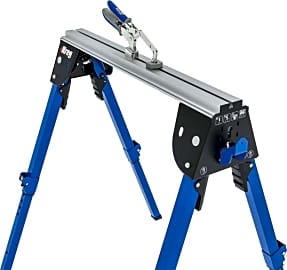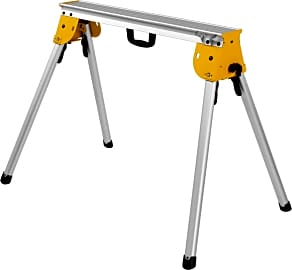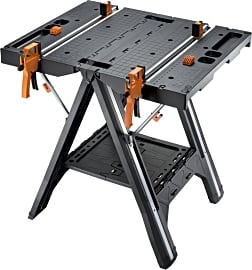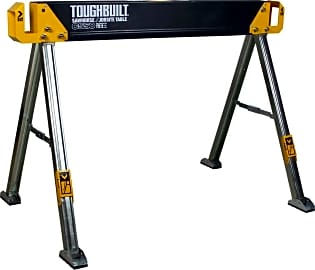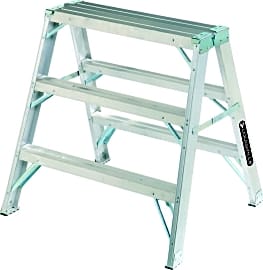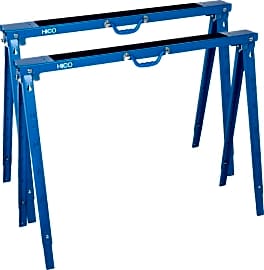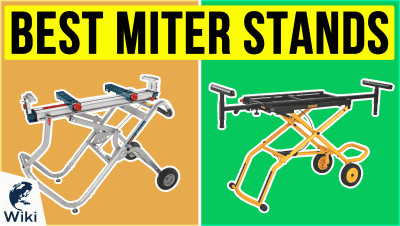The 10 Best Sawhorses

This wiki has been updated 39 times since it was first published in October of 2015. For the contractors and handypersons out there, whatever project you are working on next, be it drywall, painting or carpentry, one of these sawhorses will give you the helping hand you need to make the job go a lot faster. Many can be used to create a large table out of a couple of two by fours and a flat piece of wood, while some fold up compactly for convenient storage and transport. When users buy our independently chosen editorial selections, we may earn commissions to help fund the Wiki.
Editor's Notes
August 27, 2019:
Sawhorses are a helpful addition on almost any jobsite, even those where you may not even be cutting things. For example, models like the Metabo HPT 115445M, Kreg KWS500, and ToughBuilt C550 have two by four cutouts that allow you to turn two units in a giant work table, and the Louisville Ladder L-2032 doubles as a stepladder to help you get at those hard to reach places. The Worx Pegasus doubles as a work bench, and the Rockwell RK9003 JawHorse can be used as a vice or miter stand.
While we often recommend multipurpose tools that can accomplish a variety of jobs, we realize some people prefer simplicity over versatility. For the purists out there, we have included the DeWalt DWX725, PortaMate PM-3300T, and Hico USH1700-B.
Of all the models we have included on our list, the ToughBuilt C550, Kreg KWS500, DeWalt DWX725, and Hico USH1700-B are the strongest, with a single unit being able to support at least 1,000 pounds, if not more.
Special Honors
B&B Mega Horse PN 3820 Built for heavy-duty industrial use, this pipe stand can support up to 12,000 pounds, so the chances of overloading it are practically nonexistent. It has an A-frame leg design with cross braces between the legs, as well as braces that run from the center of the beam to ensure optimal stability and strength. However, it isn't foldable for storage or transport, and it weighs over 100 pounds. bbpipetools.com
Types of Sawhorses
Even the lightweight sawhorses are built to withstand a lot of weight and can support the pressure of a circular saw and even hold several heavy duty tools at once.
The sawhorse is a simple, yet essential tool for anyone who works in construction or carpentry or loves to complete do-it-yourself projects. Most sawhorses are made of the same basic type and construction and serve similar functions. They are usually constructed of two sets of legs that are joined together by a beam at the top. They also have brace beams that give it that infamous A-shape.
There are four basic types of sawhorses, the most common of which is the wooden sawhorse. Many people opt to make their own wooden sawhorses, but some prefer to buy them already made to get features that they can't construct. If you cut into the wooden sawhorse while working, it will not cause any damage to your saw blade and can be repaired easily.
The second most popular type of sawhorse is metal. These are often made with hinges for easy folding and portability and are used for cutting other types of metal. They can be found in industrial settings. They are less common for residential projects because the metal can damage wood. Most metal sawhorses are made from steel, and if they are well cared for and kept out of the elements, they will last for several years.
The third and even less common type of sawhorse is the chainsaw horse. It is a heavy duty sawhorse and is difficult to build at home. This sawhorse is used for cutting large pieces of wood or logs with a chainsaw. It is often found in the timber industry. It is usually made out of metal because of its durability, but some of these sawhorses are still made from wood.
Finally, some manufacturers sell lightweight sawhorses that are built specifically for portability. Some of these sawhorses even have storage compartments for holding your tools, and many fold for added transportation convenience.
You will find sawhorses being used in pairs on construction sites or home improvement projects. They can hold wood or other materials for measuring and cutting and can even hold wide planks or plywood to create a functional workbench. Even the lightweight sawhorses are built to withstand a lot of weight and can support the pressure of a circular saw and even hold several heavy duty tools at once.
A Simple Tool But A Difficult Decision
For a product with such a basic design, a sawhorse has a lot of features to consider. Obviously, the sawhorse you purchase will depend on your intended use and the amount of versatility you require.
Choose the material you want. Most sawhorses are made from two basic materials: wood or steel. A steel sawhorse is longer lasting and often offers more adjustment options and portability. However, a wooden sawhorse is gentler on your materials and easy to repair should it be damaged.
However, a wooden sawhorse is gentler on your materials and easy to repair should it be damaged.
Choose the size. Perhaps you need one or two small sawhorses for simple home projects. Or maybe you want something large to help you create a wide work space. Today’s manufactured sawhorses come in a variety of heights, lengths, and weights. Many are adjustable as well.
Choose your desired features. Both wooden and steel sawhorses are available with folding options for easy storage. Some have shelving to keep all of your necessary tools within easy reach. Also consider whether you want your sawhorse to be multi functional. Some can double as step ladders, welding stations, miter stands, and more.
Choose the weight capacity. The weight capacity varies depending on individual specifications and user needs. They can range anywhere from a capacity of 300 to 1,000 pounds so you can accommodate any job.
Consider portability. Manufacturer sawhorses are built with sturdy materials and versatility so they can be easily folded and carried. Some have carrying handles and even come with convenient cases to protect them from the elements. The steel or aluminum sawhorses are the most portable on the market, although some of the wooden ones are made to easily fold and store.
Don’t forget comfort. The height of your sawhorse is going to play a major role in your comfort while you are working. The average sawhorse stands at twenty-four to twenty-seven inches which is perfect for most people. However, if you are shorter or taller than average, you should probably check into a sawhorse with adjustable legs to avoid putting unnecessary strain on your back.
A Brief History of the Sawhorse
The exact origins and history of the sawhorse are unclear, but what is clear is that it has been used for centuries. There is an illustration in the book De Re Metallica, published in 1556, that depicts a millwright supporting beams between two sawhorses. It seems that the sawhorses were made of halves of logs with legs secured in place against them. Other documented uses of sawhorses were in the mid to late eighteenth century.
The exact origins and history of the sawhorse are unclear, but what is clear is that it has been used for centuries.
The basic form of the sawhorse is so useful and functional that it hasn’t changed over centuries of continuous use and advancements. Even though new elements such as shelving for tool storage, height adjustments, and folding for portability have all been added over the years, the basic shape and construction remains the same.
The sawhorse remains one of the most necessary and useful tools found in any wood or metal worker shop, and sawhorse varieties made from a range of materials can be found in garages and construction sites around the world.
The most complicated type of sawhorse in existence is the French trestle, and it is considered more of a work of art functioning as a base for creating ornate roofs. The complicated creations do not change the basic functionality of the sawhorse but simply add an aesthetically pleasing appearance.


